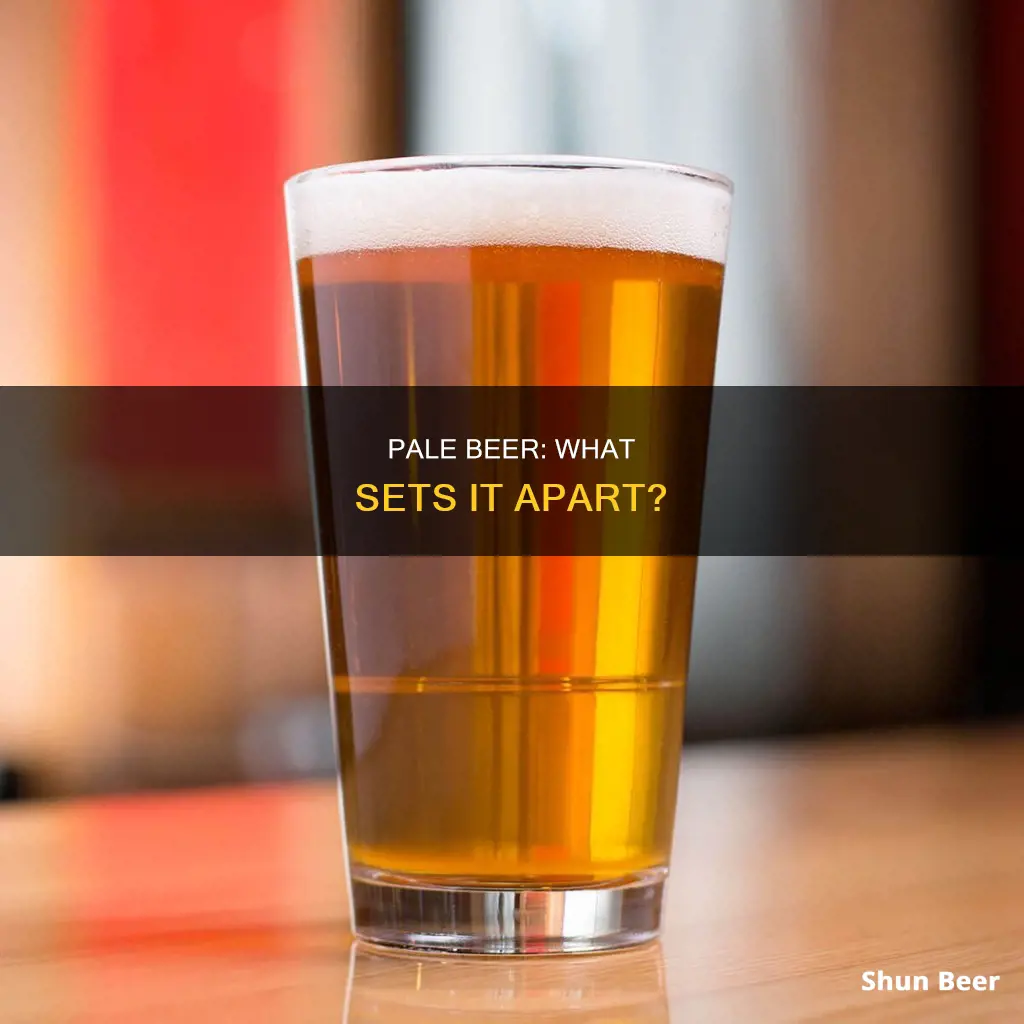
Pale ale is a style of beer that originated in England in the early 1700s. It was developed as an alternative to the standard dark beers of the time, with a lighter colour and a more mild palate. Pale ales are brewed with pale malt and ale yeast, and are known for their malty flavour, medium body, and light golden or amber colour. They typically have a lower alcohol content than IPAs, with most ranging from 4-6% ABV.
What You'll Learn
- Pale ales are a bridge between light lagers and dark stouts
- They were first brewed in England in the 1700s
- They have a malty, medium-bodied, light golden or amber colour
- They are not as strong as other beers, with a lower ABV
- There are many types of pale ale, including American, British, Amber and Blonde

Pale ales are a bridge between light lagers and dark stouts
Lagers are typically a beer drinker's first introduction to the world of beer. They are clean, consistent, and well-made, with a light and malty taste. They are fermented with bottom-fermenting yeast at cold temperatures, which results in a longer fermentation process.
Stouts, on the other hand, are dark, roasted ales. They have a bitter coffee taste and a thick, creamy head. Stouts are less sweet than porters, another type of dark beer.
Pale ales, on the other hand, are hop-forward with a malty flavour. They are full of flavour, but not too heavy, making them very approachable. The colour ranges from golden to amber. In terms of bitterness, they fall somewhere between lagers and stouts, with 20-50 IBUs.
The primary contrast between pale ales and lagers is in the yeast. Pale ales are brewed with top-fermenting ale yeast, while lagers use bottom-fermenting yeast. Pale ales are also slightly opaque, in contrast to the clarity of lagers. Additionally, the malt flavour is more prominent in pale ales, giving them a bitter and hoppy taste.
In conclusion, pale ales occupy a middle ground between light lagers and dark stouts in terms of colour, flavour, and bitterness. They combine the approachability of lagers with the complexity of stouts, making them a popular style of beer.
Stout vs Porter: Unveiling Beer's Dark Secrets
You may want to see also

They were first brewed in England in the 1700s
The story of pale ale began in the early 1700s when brewers in Burton-on-Trent in England were looking for a way to produce a more consistent and paler beer. The kilns of the day used wood, which was difficult to control and often resulted in dark roasted or even scorched barley. The solution came in the form of coke, a processed form of coal that burns hot and steady, which gave them the desired clear, amber- or copper-coloured ale. This new style of beer was first referred to as "pale ale" around 1703.
By the 1780s, advertisements for "light and excellent" pale ale were appearing in the Calcutta Gazette. The term English bitter first appeared in the early 19th century as part of the development and spread of pale ale. Breweries tended to designate their beers as "pale ales", while customers would refer to the same beers as "bitters". It is thought that customers used the term "bitter" to differentiate these pale ales from other less noticeably hopped beers such as porters and milds.
The late 18th century saw the development of India Pale Ale (IPA). The first known use of the term "India Pale Ale" appeared in an advertisement in the Sydney Gazette and New South Wales Advertiser on 27 August 1829. Demand for the export style of pale ale, which had become known as "India Pale Ale" (IPA), developed in England around 1840.
A pale and well-hopped style of beer was developed in Burton-on-Trent in parallel with the development of India Pale Ale elsewhere. Previously, Englishmen had mainly drunk stout and porter, but bitter (a development of pale ale) came to predominate. Beers from Burton were considered to be of particularly high quality due to the synergy between the malt and hops used, as well as the local water chemistry, especially the presence of gypsum. This extensively hopped, lighter beer was easier to store and transport, favouring the growth of larger breweries. The switch from pewter tankards to glassware also led drinkers to prefer lighter beers.
EBC Beer Shipping: State-by-State Availability and Restrictions
You may want to see also

They have a malty, medium-bodied, light golden or amber colour
Pale ales are a style of beer that originated in England in the early 1700s. They were first created as an alternative to the standard dark beers of the time. English brewers eventually became more skilled in controlling the malt intensity, crafting a lighter beer with a more mild palate.
Pale ales have a malty, medium-bodied, light golden or amber colour. They are not as strong as some other beers, providing a tasty option for those looking for a more delicate hop experience. Most pale ales range from 4-6% ABV.
The original pale ales were brewed with pale malt and ale yeast, and the style has since evolved to include a variety of sub-styles, including American Amber Ale, American Pale Ale, Blonde Pale Ale, and English Pale Ale.
The American Amber Ale, also known as the American Amber Pale Ale, has a robust flavour profile thanks to the use of caramel and crystal malts, which give the beer its vibrant colour, flavour, and body. It has a medium-to-high malt profile with a low caramel profile.
The American Pale Ale is a fruity, floral brew with a medium-bodied flavour profile. It is less bitter than other ales and has a subtle flavour. It is often paired with classic American cuisines such as grilled steak or burgers, or sweet and fruity dessert items like apple pie.
The Blonde Pale Ale, also known as the Golden Pale Ale, is a smooth, drinkable option containing many malts or hops. It is popular for its simplicity, rounded flavour, and aesthetically pleasing appearance. It pairs well with light and fresh sandwiches or main courses, such as a Caprese salad or mozzarella and tomatoes on ciabatta. It is also a good choice for heavier dishes like spaghetti and meatballs.
The English Pale Ale, also known as the English-Style Pale Ale or "extra special bitter" (ESB), displays an even balance between malt and hop bitterness. Aromatic English hops give the ale a slightly pungent flavour and are evident in the fruitiness of its taste and scent. It pairs well with simple, traditional meals such as bread puddings in various sweet, decadent flavours.
Soju and Beer: What Sets Them Apart?
You may want to see also

They are not as strong as other beers, with a lower ABV
Pale ales are not as strong as other beers, with a lower ABV. The alcohol content of a beer is measured by its ABV (Alcohol By Volume), which indicates the percentage of the drink's liquid content that is alcohol. Pale ales typically have a lower ABV compared to other beers, making them more approachable and easier to drink.
The original pale ales, which were created in England around 1703, had a lighter colour than other beers of that time due to the use of high-carbon coke in the malting process. This resulted in a golden to amber colour that is characteristic of pale ales. While the colour was a defining feature, the term "pale ale" also referred to the use of pale malt in the brewing process.
Over time, the expression "pale ale" became synonymous with "bitter", as customers used the term "bitter" to differentiate these paler, more hopped beers from other less hopped beers like porters and milds. The term "bitter" referred to the higher levels of hops used in brewing, which contributed to a more bitter taste.
Today, pale ales typically have a moderate strength and are considered to be hop-forward with a malty flavour. The specific ABV can vary within the pale ale family due to different brewing practices and hop quantities, but they generally fall within the range of 4% to 7% ABV. For example, American pale ales are typically around 5% ABV, while Australian pale ales may reach 6% ABV.
In comparison to other beers, such as India Pale Ales (IPAs) or stouts, pale ales generally have a lower ABV. IPAs can have ABVs ranging from 5% to 11% or higher, depending on the style, while stouts can also reach higher ABV levels. Therefore, pale ales offer a more moderate alcohol content while still delivering a full flavour.
Sour Beers: A Unique Fermentation Process
You may want to see also

There are many types of pale ale, including American, British, Amber and Blonde
Pale ale is a golden to amber-coloured beer style brewed with pale malt. The term "pale ale" was first used in England around 1703 for beers made from malts dried with high-carbon coke, resulting in a lighter colour than other beers of that time. Since then, different brewing practices and hop quantities have led to a range of tastes and strengths within the pale ale family.
One style of pale ale is American pale ale (APA), which was developed in the United States around 1980. APAs tend to be around 5% ABV and are characterised by the use of significant quantities of American hops, particularly Cascade hops. This style is similar to American India Pale Ale (IPA) but with less assertive hopping, and to Amber Ale, though Amber Ales are darker and maltier due to the use of crystal malts. Amber Ales, also known as Red Ales, are named for their golden to amber colour, which is derived from the use of caramel and crystal malts. They are typically brewed at warmer temperatures for a shorter amount of time than lager-style beers, and are known for their toasted, toffee flavour.
Blonde ales, sometimes referred to as golden ales, are another style of pale ale. They are very pale in colour and tend to be clear, crisp, and dry, with low-to-medium bitterness and aroma from hops, and some sweetness from malt. They are highly approachable and easy to drink, with no dominating malt or hop characteristics.
In addition to these styles, there are also British and Australian pale ales, each with their own unique characteristics.
Exploring Samuel Adams' Diverse Beer Flavors
You may want to see also
Frequently asked questions
Pale ales are typically golden to amber in colour, but they can also be darker shades of amber.
Pale ales are brewed with top-fermenting ale yeast, whereas lagers use bottom-fermenting yeast. Pale ales are also more bitter and hoppy than lagers.
IPAs (India Pale Ales) are a type of pale ale with a higher alcohol content and a stronger, more bitter taste. IPAs also have a drier mouthfeel and a stronger aftertaste.
Pale ales were first brewed in England in the early 1700s as an alternative to darker beers. The term "pale ale" was first used in 1703 to describe beers made with malts dried with high-carbon coke, resulting in a lighter colour.
Pale ales have a balanced blend of ingredients, with a mild, approachable flavour. They have a malty profile with a moderate amount of hops, resulting in a bitter and hoppy taste.







